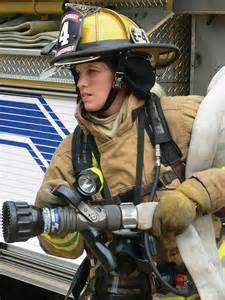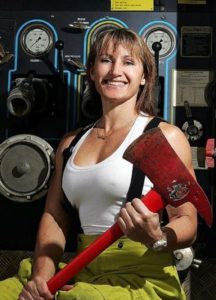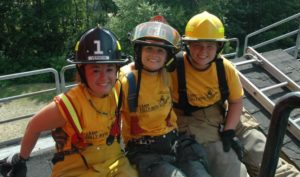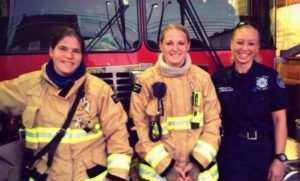By: Robert Avsec, Executive Fire Officer
So I’m working on the next post for this blog , and I  Google the term “Female Firefighter Pictures” because I’m looking for pictures of our sister firefighters in action to insert in the post. Why is it the search results on the first page (35 photos) showed just 8 pictures of a female firefighter, in turnout gear and engaged in firefighting, while there were 27 pictures of “less than combat ready” female firefighters from a variety of female firefighter calendars, past and present? (The second page showed only 4 “non-calendar” photographs of female firefighters).
Google the term “Female Firefighter Pictures” because I’m looking for pictures of our sister firefighters in action to insert in the post. Why is it the search results on the first page (35 photos) showed just 8 pictures of a female firefighter, in turnout gear and engaged in firefighting, while there were 27 pictures of “less than combat ready” female firefighters from a variety of female firefighter calendars, past and present? (The second page showed only 4 “non-calendar” photographs of female firefighters).
See Related: 10 Things I Want My Daughter to Know About Working Out

Now I can find pictures when I need them, so I’m not lamenting the lack of the type of pictures I was seeking (women firefighters in action), but rather the overabundance of photographs of the “female firefighter calendar” genre. Before I go on, I want to make it perfectly clear that I appreciate the female form just as much as the next red-blooded male and deeply appreciate the good works that those ladies do in producing their calendars and then very effectively marketing them. Children’s hospitals and Burn Units across the country are in better shape financially because of their efforts.
Why This Bothers Me (And should you as well)
What I am saying is that Women in the Fire & EMS world continue to struggle for equal and fair treatment in the fire service culture. They are overwhelmingly the targets of sexual harassment on the job because too many of my male fire service colleagues can’t differentiate between a singles bar and the fire station. How many of those “female firefighter calendars” do you think are hanging in the fire department lockers of male firefighters across the USA? They’re not hanging there because the owner admires the turnout gear or the firefighting tools in the picture, are they?
Photographs and other imagery that predominantly portray female firefighters as sexual objects first, and firefighters second, communicates a very powerful “marketing message” whether men and women in the fire service choose to accept it or not. (Don’t think so? Just ask any marketing professional “worth their salt” what they think).
Changing channels
 Fire and EMS departments across the country say they want to have a more diverse workforce, particularly one that includes more women. Yet what is the message that’s being communicated to young women and girls about the Fire and EMS world and the women who are firefighters? Any woman or girl who does the same Google search that I did, “Female Firefighter Pics” is going to see page after page of results that “say” to them:
Fire and EMS departments across the country say they want to have a more diverse workforce, particularly one that includes more women. Yet what is the message that’s being communicated to young women and girls about the Fire and EMS world and the women who are firefighters? Any woman or girl who does the same Google search that I did, “Female Firefighter Pics” is going to see page after page of results that “say” to them:
- If you’re not physically beautiful, you can’t be a firefighter;
- You have to take off your clothes to be a firefighter; and
- A female firefighter doesn’t do the same tough and physically demanding job of a “real” firefighter, they’re just “eye candy” for male firefighters and other men.
I think women add a tremendous amount of positive things to any Fire and EMS department. I know many and have had the privilege and honor of working with many during the course of my active duty career. But if we want to attract more good and qualified women to join the Fire and EMS profession, we’ve got to address this issue of imagery and the negative impact that it’s having.
In a previous post on this blog I expressed my opinion that if Fire and EMS departments want to attract the best possible candidates of all genders, races, ethnic groups, etc., then they have to become better at how they market their organizations.
Those marketing efforts should include taking a good look at the current marketing media, e.g., brochures, videos, mass mailings, posters, etc., to see how your current membership is portrayed. Do these mediums show a representative cross-section of your organization? Do they highlight the contributions of a variety of your membership, not just white males? Do they show women and other minority groups in leadership roles?
When the “troops” are out in public, e.g., for public education programs, are women and other minority group  members given prominent roles in the delivery? For example, when demonstrating what firefighters do, or showing school children what a firefighter looks like when fully dressed in their PPE and SCBA, are women and other minority members filling that role? Who conducts the demonstration of the apparatus, e.g., engine or truck operations? Is it always one of the guys on the crew?
members given prominent roles in the delivery? For example, when demonstrating what firefighters do, or showing school children what a firefighter looks like when fully dressed in their PPE and SCBA, are women and other minority members filling that role? Who conducts the demonstration of the apparatus, e.g., engine or truck operations? Is it always one of the guys on the crew?
As the title of this post states, “a picture is worth a thousand words.” The images and real-life scenarios that you and your department present to the public every day are having an impact—both positive and negative—on your future recruiting efforts. And whether yours is a career or volunteer staffed department, can you really afford that?
That’s my “two-cents” worth, what’s yours?
Related Sites You Might Find Interesting
The 100 Best Websites For Women, 2013 (Forbes, Inc.)
See Related: 7 steps to an inclusive fire department culture
 Fire & EMS Leader Pro The job of old firefighters is to teach young firefighters how to become old firefighters!
Fire & EMS Leader Pro The job of old firefighters is to teach young firefighters how to become old firefighters!